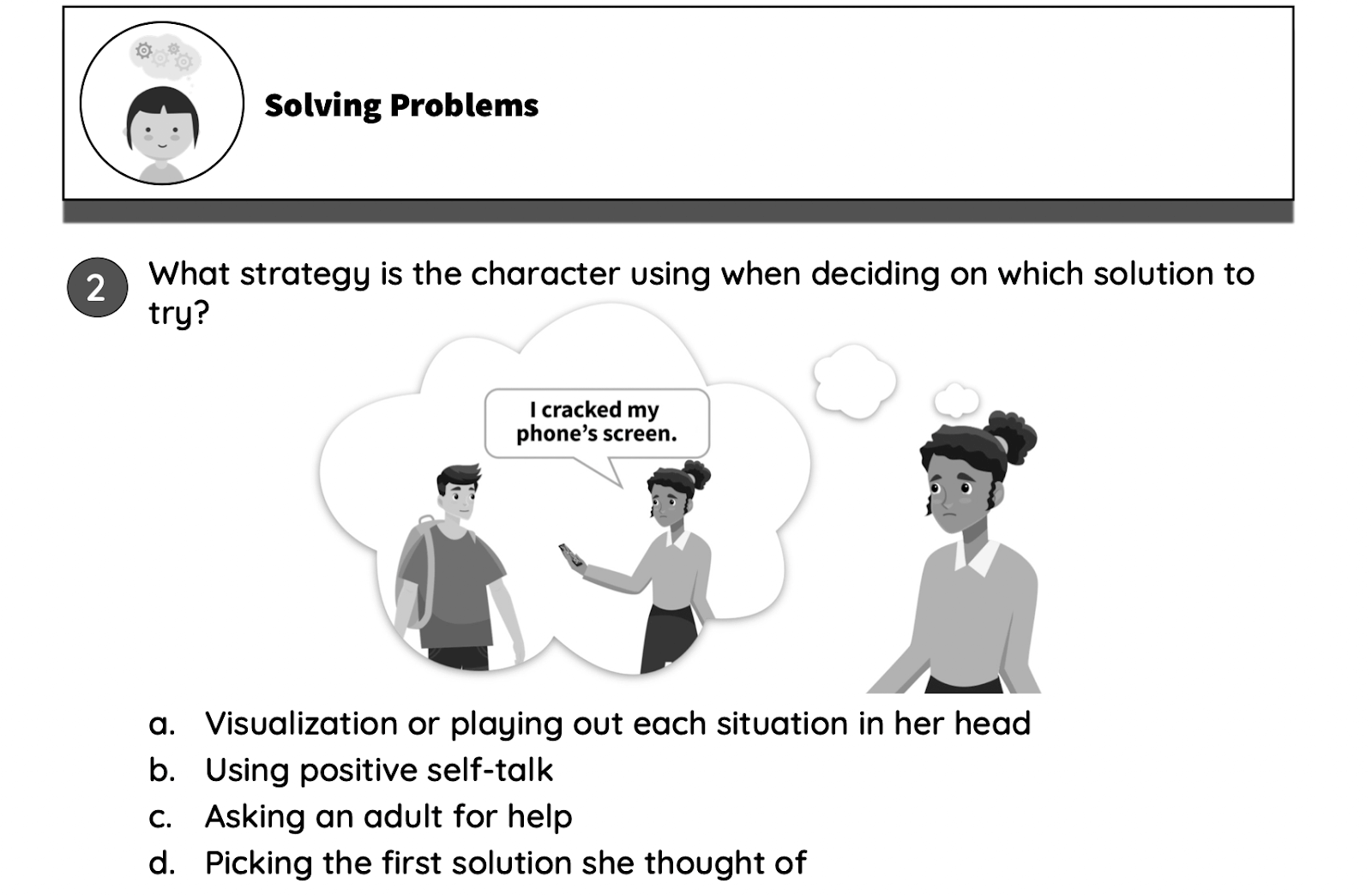No-Prep Late Elementary Lessons to Teach Problem Solving
Get free social skills materials
No-prep lessons on self-regulation, emotional recognition, conversation skills, and more.
Sign up hereWelcome back! Iris here. This lesson is for learners grades 3-5 (late or upper elementary) and is a topic I consider of utmost importance—problem solving!
Everyday Speech’s Social Communication Curriculum provides a thoughtful and pre-prepped roadmap for teaching problem solving.
Materials I Use:
- Video: Solving a Problem (5 minutes) to cover concept review
- Interactive: Using “I Feel” Statements with Family
- Visual Tool: 5 Steps to Problem Solve
- Tip: Print this on a letter-sized color poster or put the steps on an index card for your learners to keep at their desks. This will serve as a friendly reminder of what steps to take next time they have a problem to solve. Another option is to print it on a blank business card and share it with parents to use as a keyring or with teachers to add to a lanyard.
How I Teach Problem Solving:
Start your lesson with the 5-minute Solving a Problem video to provide a concept overview.
The Problem Scale is one of my favorite strategies in the Solving a Problem video. Ask learners to refer to this scale next time they face a challenge. Is it a big problem, a medium problem, or a small problem? How can they use this information to respond accordingly?

This video also covers visualization. This is the process of making mental pictures of possible solutions to a problem. Encourage your learners to use visualization next time they’re feeling stuck or frustrated with a challenge in their life.
The video ends by encouraging learners to try again if the problem-solving solution they chose did not work as desired or expected.
Encourage Group Discussion About Problem Solving and Share Your Experiences
Think about the concept of “trying again” in your own life—what does trying again look like in your lived experience?
One of the parts I treasure most about direct student work is sharing stories and mistakes (sometimes humorous in retrospect). Reflection and post-visualization are helpful tools for moving forward and trying something again.
I find that my son, especially when he is tired from a long moment of dysregulation, will listen when I share personal stories of times I struggled. Sometimes he follows up, typically several weeks later, with a story of his own. When this happens, I ask him what he did or said to his peers in the story.
When learners apply problem-solving steps to real-life experiences, then reflect on their personal stories, the learning solidifies and stays with them.
Further Practice:
Email or print the video companion worksheet
(preview below) to send home or share with another member of your learner’s educational team (e.g., an outside provider, a paraprofessional, etc.). This is one of the quickest and clearest ways to collaborate!
Do you want access to our complete no-prep curriculum?
{{cta(‘df2570d0-50ab-4151-b34d-203ec1f69ab3’)}}
Other Problem-Solving Activities to Try with Your Learners:
- Show an age-appropriate TV-show clip and apply the 5 Steps to Problem Solve and problem scale (from the Solving a Problem video) to the characters and their conflict or dilemma.
- Take a current event (pro tip: start a free account on Newsela) your learners have read about or are curious about and apply the 5 Steps to Problem Solve and problem scale to see what solutions your learners come up with.
- If you’re looking for a flexible tech extension/visual guide, try Trello (free). With Trello, you can visually walk through problem-solving steps and subsequent actions and feelings. Share your boards with learners so they can follow along. Add notes and checklists to the cards as needed.
Sarah Ward, M.S., CCC-SLP maps Get Ready*Do*Done, her executive function planning method, to Trello to coach students with organization and problem solving.
Another option is to use Trello to list the 5 problem-solving steps and move them to the “done” column when completed. Trello boards are easy to share and assign to others too!

Example Trello board pictured above
- Use graphic novels, any picture book by Julia Cook, and choose-your-own-adventure stories (my favorites are What Should Danny Do? and What Should Darla Do? by Ganit and Adir Levy) to practice problem-solving scenarios. Copy a page or create a Powerpoint with a scene from a book. Then, create speech or thought bubbles for learners to fill in. Ask them to guess what each character would say as part of the problem-solving process.
- Use games to practice problem solving!
-
- Run a game show such as Jeopardy or use one of many pre-made Everyday Speech games, like Problem Peak (access with a free 30-day trial).
- Use a traditional board game, or take it outside with 4-square or dodgeball, for an active way to drill problem-solving steps.
- Try lightning-round style between turns (e.g., read quick scenarios, give multiple choices, and ask learners to shout their responses as quickly as possible). Another option is to read problem scenarios and ask learners to shout where they think it lands on the problem scale.
- Share the importance of “I feel” statements. “I feel” statements are helpful for problem solving because it opens the door for communication by letting others know where you stand. Naming the emotion often helps us feel calmer. Use the Using “I Feel” Statements with Family activity (or send it home) to practice this skill.
Further Discussion:
As learners gain fluency with problem-solving strategies. Challenge them to reflect on the following:
- What is the toughest step?
- What is the easiest?
- What is an instance where they tried again and what happened afterward?
Some of my richest interactions with learners have come out of questions like these.
Problem Solving and IEP Goals
What does a measurable, specific Individualized Education Plan (IEP) goal targeting problem solving look like?
“By (date), provided multimodal supports (e.g., video models, visualization, narrative structure), (learner’s name) will identify a plausible solution to a hypothetical or real (past/present) problem in 80% of opportunities, over 2 sessions, as measured by SLP-charted data.”
I love to bring visuals to IEP meetings. That way all team members (e.g., administrators, teachers, and family members) can refer to the visual and get on the same page about tools and shared language!
Rehearsal and extension activities could include visiting hypothetical problems as a group and using the 5 Problem-Solving Steps and the Problem Scale.
Key Takeaways:
Teaching problem solving to late-elementary learners can have a big impact inside the classroom and beyond!
As with every session, preview, practice, and nurture ownership and independent carryover into real-life problems.
Our clinical caseloads and school days are packed now more than ever. Everyday Speech’s no-prep curricula can save you time and stress!
{{cta(‘df2570d0-50ab-4151-b34d-203ec1f69ab3’)}}
About the Author:
 Iris Wong joined Everyday Speech as a contributor in 2021. Over the last decade, she has been a Speech Language Pathologist in PreK-12 public schools, private practice, international schools and community health based early intervention. She currently lives in the San Francisco Bay Area with her husband, two kids and senior dog. Visit her at https://www.linkedin.com/in/iris-l-wong/
Iris Wong joined Everyday Speech as a contributor in 2021. Over the last decade, she has been a Speech Language Pathologist in PreK-12 public schools, private practice, international schools and community health based early intervention. She currently lives in the San Francisco Bay Area with her husband, two kids and senior dog. Visit her at https://www.linkedin.com/in/iris-l-wong/


